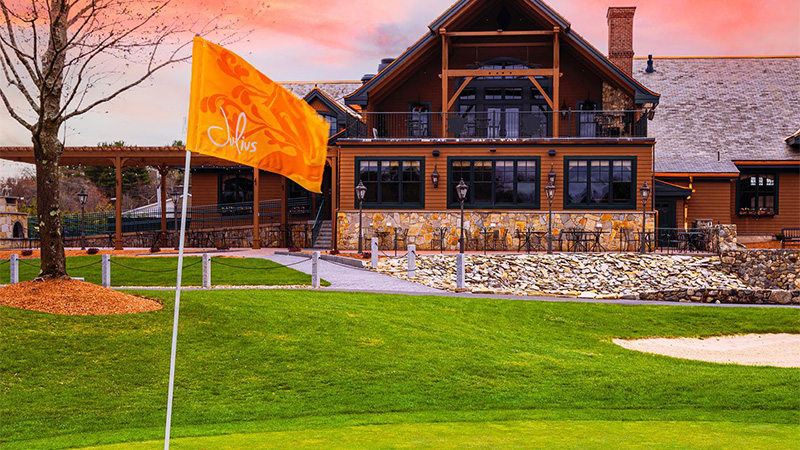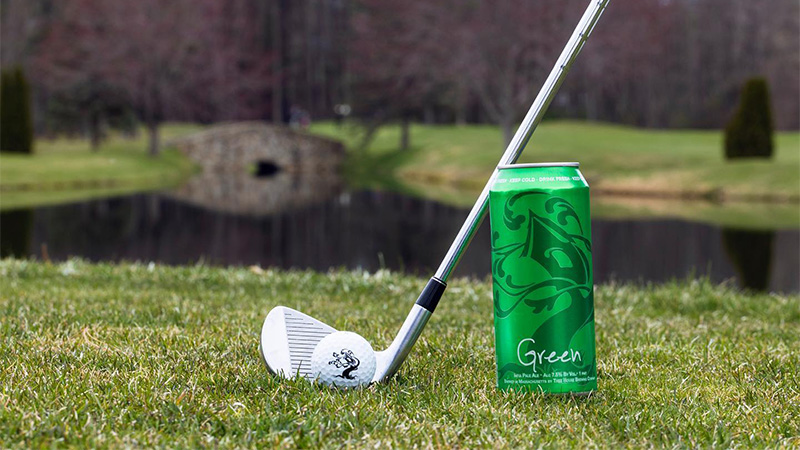The earliest images posted on Instagram seemed too surreal to be true. Golf balls with the swervy, wind-blown tree logo on them. Cans of Green on the tee box. An orange Julius flag in the 1st hole pin.
Was Tree House Brewing Company, one of the most acclaimed breweries in America and producers of VinePair’s No. 1 most important IPA in the world (the aforementioned Julius), really opening a golf course in suburban Massachusetts?!
Well, it wasn’t April Fool’s Day and Tree House, perhaps more than any other craft brewery in America, has certainly always pursued diverse and off-beat interests.
A Growing Tree House
The small craft brewery initially started in Nate Lanier’s kitchen before officially opening in a barn in the sleepy town of Brimfield, about an hour west-southwest of Boston, in 2011, before moving to likewise sleepy Monson in 2013. Almost instantly, the brewery’s juicy IPAs like Julius, Green, and Haze began to create daily lines of beer geeks. By 2015, Good Morning, a maple syrup imperial stout only available in a growler, had ascended to Beer Advocate’s No. 1 beer in the world. (Today, a total of 32 Tree House beers rank on the Top 250 list.)
This meteoric success would see the need for rapid expansion. And yet, unlike other top hazy IPA producers of this era, Tree House never relinquished full control — never distributing cans to retail, rarely allowing kegs to go to bars, and even keeping the brewery off the grid for a while.
By 2017, Tree House had opened a 130,000-square-foot, $18.5 million brewery in nearby Charlton, producing 150,000 barrels of beer per year. Every time I’d visit, I was shocked, not only by how many customers were there, but by how many great beers were on offer and how quickly iPad-toting employees were able to handle the crowds and process orders. In many ways the efficiency felt like an Apple store that just so happened to be selling beer in the woods.
It seemed like Tree House was printing money, but that didn’t stave off its ambitions. The team didn’t rest on their hazies and instead started brewing unpopular styles like altbiers and brown ales. They launched a coffee business, began to offer pizzas, set up hiking trails and half-marathons, even started distilling spirits, everything from bourbon and rye to rum and vodka to apple eau de vie, pickle gin, and Key lime aperitivo.
In 2019, Tree House opened a cidery on a 100-acre farm in Woodstock, Conn., where it would also sell fresh fruit and vegetables to the community. In 2020, it opened another brewery in the seaside town of Sandwich in Cape Cod, now selling canned RTDs and cold brew.
“There is truly no grand plan, just to do great work and provide something the public can value and look forward to.”
It would all be so laughable, how many pies that Tree House had its fingers in — in this era when craft beer sales are slumping, when other craft breweries are consolidating or closing, certainly not innovating — if not for the fact that everything, literally everything Tree House has continued to produce and open, weren’t so impressive and coveted by its fan base.
But surely a golf course would finally be the brewery’s Icarus moment?
I’m Sorry… What?
“Great companies are great regardless of market conditions, and we put our focus each day into doing the best work that we can,” Nate Lanier, the CEO, co-founder, and head brewer of Tree House, who rarely grants interviews, told me. “There is truly no grand plan, just to do great work and provide something the public can value and look forward to.”
In the midst of the pandemic, Lanier began looking for a location north of Boston to add yet another satellite brewery. He took tours of old garages and even a former Petco, but nothing seemed quite right for the brewery’s ethos and aesthetic. And then, he stumbled upon Tewksbury Country Club in the Merrimack Valley, about 19 miles from Boston. He instantly fell in love with its slate roofs and copper trim.
It wasn’t for sale, but it wasn’t exactly doing great business during the pandemic, either, forced to close for a year and a half and still facing restrictions upon reopening. Lanier, who spent his entire childhood on golf courses and holds a 10 handicap, felt it was a perfect fit for Tree House and, luckily, the golf course’s owner, Marc Ginsburg, was willing to part with it.

By early May of 2022, the deal had been finalized and announcements were made on Tree House’s social media channels. Many followers, like me, were simply confused by this new venture.
“I’m sorry what?” wrote one man. “Lol wow, moving into the 1 percent! Lookin real boujee!!! (sic)” wrote another. While another’s assessment was simply: “Shark jumped.”
“The craft beer culture and golf culture definitely overlaps.”
And, I have to admit, I kind of agreed with them. While I’ve always loved craft beer and golf, I’ve never exactly noticed a demographic overlap. The slovenly T-shirt-clad beer geek vis-à-vis the polo-and-khakis duffer. The serenity of the golf course versus the metal blasting tap room. Most golf clubhouses, even in this era, still stock the most humdrum macro beers and serve the most simplistic mixed drinks.
Lanier doesn’t agree with me, however. “You’re wrong. The craft beer culture and golf culture definitely overlaps,” he says, though he claims that was not the impetus for his purchase. Sure, I think about how golf blew up during the pandemic, what with it being a rare outdoor, socially distanced activity. How with the temporary closure of clubhouses and cart girls, many golfers began to bring their own alcoholic drinks, everything from Togronis to, yes, craft beer.
But Lanier isn’t even thinking about attracting the typical Tree House fans who have been waiting in lines since the Monson days, or still flexing their JJJJuliusss scores on Untappd.
“Every [Tree House] project is unique and each location organically develops its own culture, its own customer base, and its own feel,” he says.

Lanier feels like he has a unique understanding of not just craft beer drinkers, but golfers as well. “The assumption from the general public has been ‘they know how to run a brewery, but what makes them think they know how to run a golf course?’ And to that, I say, what makes anyone think they know how to run a golf course?”
If Tree House fails, it certainly won’t be for a lack of effort.
In just six months it has fully transformed the Tewksbury location, building new additions like a speakeasy; revitalizing the clubhouse basement to allow for a whopping 78 tap lines (though it has its own brewery system, it will mostly serve and sell beer brewed in Charlton); and fixing the course that Lanier describes as a “beaten down track,” renaming each hole after the brewery’s beloved beers like Haze and Green.
The clubhouse opened in late June of this year, just in time to screen the U.S. Open on a 180-inch Unilumin 4K screen in the soaring, timber-ceilinged grand hall. In mid-August, the nine-hole golf course officially opened. By now, people were no longer wondering why this famed IPA maker had opened a golf course, but expressing awe at how they couldn’t wait to tee up one of those Tree House logoed balls and pull a driver from their Tree House logoed bag.
As one man commented on Instagram:
“Gonna tell my kids they used to be a craft microbrewery. No friggin way they’ll believe me.”
